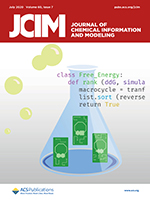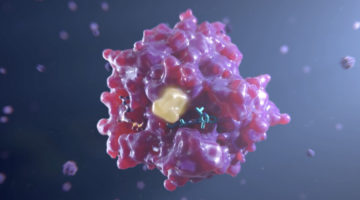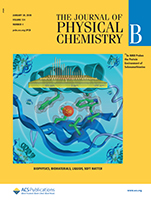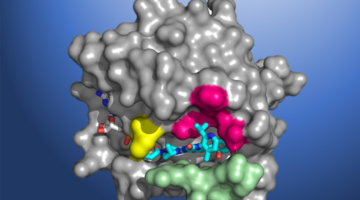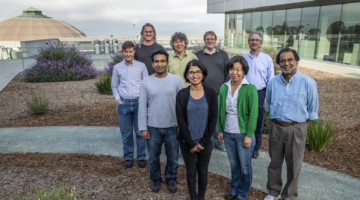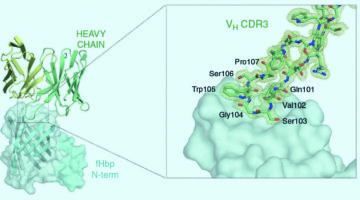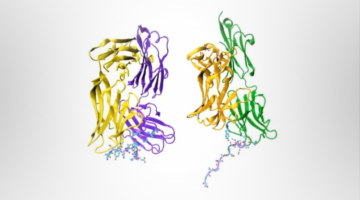Free energy perturbation methods represent a paradigm shift in drug discovery, where computational methods inform benchtop activities. Macrocycles are highly constrained molecules, often resulting in nonintuitive structure–activity relationships requiring lengthy synthetic routes. Free energy perturbation methods can be used to predict potency, guiding synthetic chemistry efforts to de-risk complex synthesis. Read more »
Staff at Berkeley Lab’s X-Ray Facility Mobilize to Support COVID-19-Related Research
X-rays allow researchers to map out the 3D structure of proteins relevant to diseases at the scale of molecules and atoms, and the ALS has been recalled to action to support research related to COVID-19, the coronavirus disease that has already infected about 2 million people around the world. Read more »
ALS Reveals Vulnerability in Cancer-Causing Protein
A promising anticancer drug, AMG 510, was developed by Amgen Inc. with the help of novel structural insights gained from protein structures solved at the ALS. AMG 510, which is currently in phase II clinical trials for efficacy, targets tumors caused by mutations in the KRAS protein, one of the most common causes of cancer. Read more »![]()
![]()
77Se NMR Probes the Protein Environment of Selenomethionine
Sulfur is critical for protein structure and function but lacks a sensitive isotope for nuclear magnetic resonance (NMR) experiments. This can be circumvented by substituting sulfur with selenium, which has an NMR-compatible isotope (77Se). To enable interpretation of the NMR data, the structures of five of protein variants were solved by x-ray crystallography to a resolution of 1.2 Å. Read more »
Unique Cancer Drug Discovered With Help From Advanced Light Source Begins Historic Clinical Trial
Errors in the KRAS gene, which encodes a crucial cell-signaling protein, are one of the most common causes of cancer. Seeking to develop a long-sought direct inhibitor, researchers at Amgen conducted x-ray crystallography of KRAS(G12C) proteins at the ALS. The high-resolution structural maps helped Amgen make the breakthrough discovery of a small pocket on the molecule. Read more »
Antibody Uses Mimicry to Block SARS Coronavirus
Protein structures not only revealed how SARS and MERS antibodies inhibit the viruses from attaching to host cells, they also revealed an unprecedented example of receptor mimicry that triggers the cell-invasion machinery of the SARS virus. The results inform efforts to prevent and treat these serious, often deadly, respiratory diseases. Read more »![]()
![]()
Scientists Capture Photosynthesis in Unprecedented Detail
Scientists have captured a more detailed picture than ever of the steps in photosynthesis, the process by which plants use sunlight to split water and produce oxygen while making the carbohydrates that sustain life on Earth. The idea is eventually to have a continuous movie of how water is split into oxygen, and how plants do that using sunlight. Read more »
Targeting Bacteria That Cause Meningitis and Sepsis
Researchers determined the structure of a human antibody that broadly protects against a bacterium that causes meningitis and sepsis. The work provides molecular-level information about how the antibody confers broad immunity against a variable target and suggests strategies for further improvement of available vaccines. Read more »![]()
![]()
Unwinding a Quadruple Helix
The double helix is not the only structure formed by DNA and RNA. Guanine-rich DNA and RNA sequences can fold into quadruple-helix structures called G-quadruplexes. Recently, researchers visualized the unfolding of a G-quadruplex by a protein called DHX36, gaining valuable insight into a potential target for drug development. Read more »
Structures Reveal New Target for Malaria Vaccine
Researchers isolated human-derived antibodies that protect against malaria, and protein-structure studies revealed the antibodies’ site of attack. The discovery paves the way for the development of a more effective and practical human vaccine for malaria, which is responsible for half a million deaths every year. Read more »![]()
![]()
